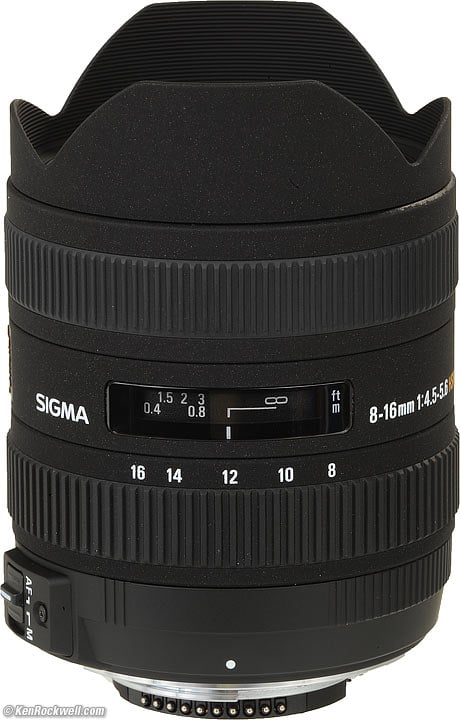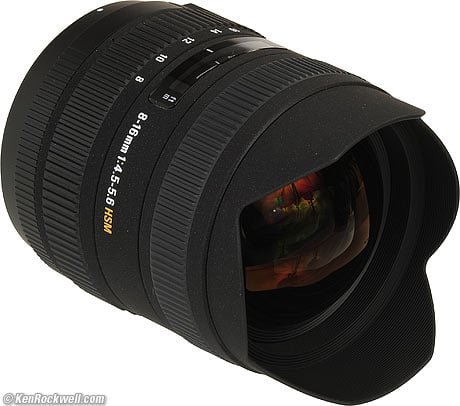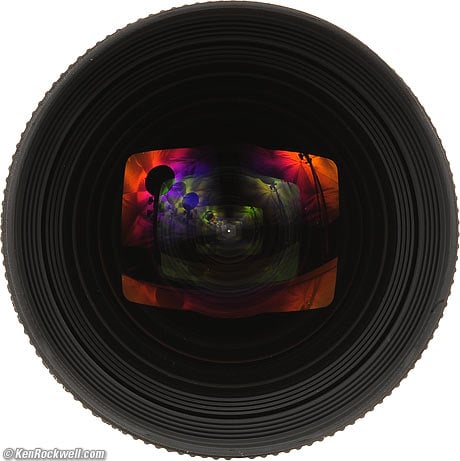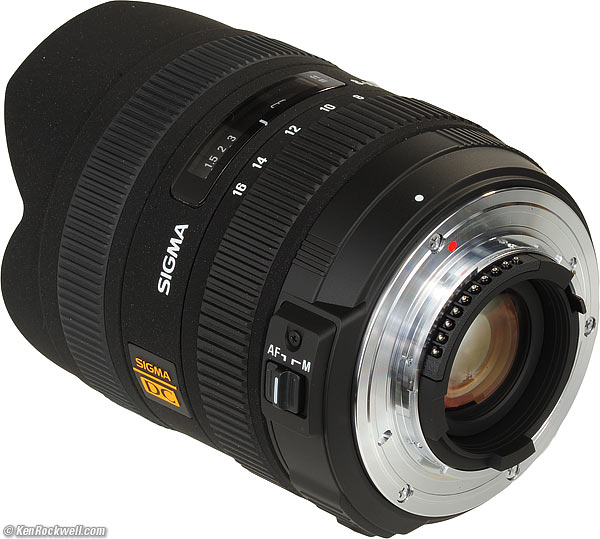Home Donate New Search Gallery How-To Books Links Workshops About Contact
Sigma 8-16mm f/4.5-5.6
DC HSM (small-format only, 2010-)
© 2010 KenRockwell.com. All rights reserved.
Intro Specifications Performance Compared Recommendations
Sigma 8-16mm f/4.5-5.6 DC HSM, Nikon AF-S G version (also comes in Canon EOS, Sony, Maxxum, Pentax and Sigma mounts, takes no filters, 19.6 oz./554g, 0.8'/0.24m close focus, about $700). enlarge. The biggest source of support for this free website is when you use these links, especially this link directly to this lens at Adorama and at Amazon when you get anything. Thank you! Ken.
September 2010 Nikon Reviews Canon LEICA Pentax
| Optics: | |
| Mechanics: | |
| Ergonomics: | |
| Usefulness: | |
| Availability: | |
| Overall: |
Ideal for: Interiors and real estate. As of late 2010, the world's widest lens for mini-format DSLRS (Nikon DX, Canon 1.6x, etc.).
Not for: Cannot use any filters, either grads to tame difficult lighting or for protection. (Sigma's 72mm filter claim is false.) Will not cover film or FX, except at 16mm.
Good News: Very sharp.
Bad News: Iffy, noisy, rattley autofocus. Even the tiniest spec of dust on the unprotected front element shows in your image due to the unlimited depth of field. Manual focus turns the wrong way on Nikon!
Introduction top
Intro Specifications Performance Compared Recommendations
|
I personally suggest Adorama, Amazon, Ritz, B&H, Calumet and J&R. I can't vouch for ads below.
|
This Sigma 8-16mm lens has super-sharp optics, but its mechanics and autofocus lag a bit behind Nikon and Canon.
This is a great lens for realtors shooting their own listings because it makes interiors seem far larger and more spacious than with any other lens, and no software fiddling is required to show huge angles.
I am addressing the Nikon version here. You may make the usual inferences when used on different camera brands.
With the Nikon version, everything works perfectly on every DX Nikon, especially Nikon's cheapest digitals like the D40, D40x, D60, D3000, D3100 and D5000.
Forget it on film or FX: it only works at 16mm; the edges go black at wider settings. If you get one for use on DX and want to pop it on your F6 or N80 for the occasional grab shot, go for it, but don't get one of these exclusively for film or FX (get a real FX ultrawide instead).
See Nikon Lens Compatibility for details with your camera. Read down the "AF-S, AF-I," and "G" columns for this lens. You'll get the least of all the features displayed in all columns, since "G" (gelding) is a handicap which removes features.
Sigma 8-16mm f/4.5-5.6 DC HSM. enlarge.
Specifications top
Intro Specifications Performance Compared Recommendations
Name top
Sigma calls this the Sigma 8-16mm f/4.5-5.6 DC HSM.
DC: Vignettes horribly on film, FX or Canon 1.3x cameras.
HSM: Hyper Sonic (autofocus) Motor.
Optics top
15 elements in 11 groups, certainly with some aspherics.
Diaphragm top
Sigma 8-16mm f/4.5-5.6 DC HSM at f/22. enlarge.
7 straight blades, not particularly even.
Stops down to f/22-29.
Coverage top
Mini-DSLR only: Nikon DX, Canon 1.6x and similar or smaller, like Sigma.
Focal Length top
8-16mm.
When used on a DX camera, it gives angles of view similar to what a 12-24mm lens gives when used on an FX or 35mm camera.
On a Canon 1.6x camera, gives angles of view similar to what a 13-26mm lens gives when used on a full-frame camera.
Angle of View top
114.5° - 75.7° on DX.
Close Focus top
0.79 feet (0.24m).
Maximum Reproduction Ratio top
1:7.8
Hard Infinity Focus Stop? top
No.
You have to hope the occasionally flaky AF system gets focus at infinity.
Focus Scale top
Yes.
Barely legible: the feet and meters scales are both in the same dim white.
Depth-of-Field Scale top
No, but almost everything is always in focus anyway.
Infra-Red Focus Index top
No.
Aperture Ring top
No.
Filter Thread top
None.
There is a 72mm thread in the cap sleeve, but you can't shoot with that attached because you get severe vignetting at every setting.
Vibration Reduction (VR) top
None.
Size top
Sigma specifies 4.16" (105.7mm) length by 2.95" (75mm) diameter, in Sigma mount.
Weight top
19.550 oz. (554.2g), measured by me in Nikon mount (21.332 oz. (604.75g) with caps).
Sigma specifies 19.2 oz. (545g) in Sigma mount.
Hood top
None; the metal petals are to protect the glass.
Caps top
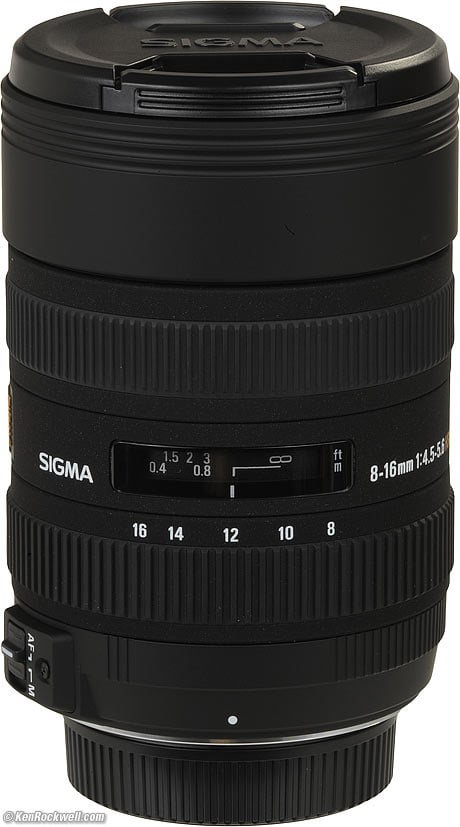
Capped Sigma 8-16mm.
There is no front cap.
Instead, Sigma supplies a tight-fitting sleeve, and a 72mm cap for that sleeve. Sigma expects you to slide the sleeve over the lens, and then attach a 72mm cap.
This works poorly, since the sleeve is tight and undoubtedly will scrape-up the black paint on the front of the lens with use.
Yes, the inside of the sleeve is felted, but it's so tight that I don't expect your paint to look good for long.
I'd leave the 72mm cap and sleeve in the box, and use an extra-small $13 LensCoat Hoodie instead.
Likewise, leave the dinky Sigma rear cap in the box, and use a real $9 Nikon rear cap instead.
Case top
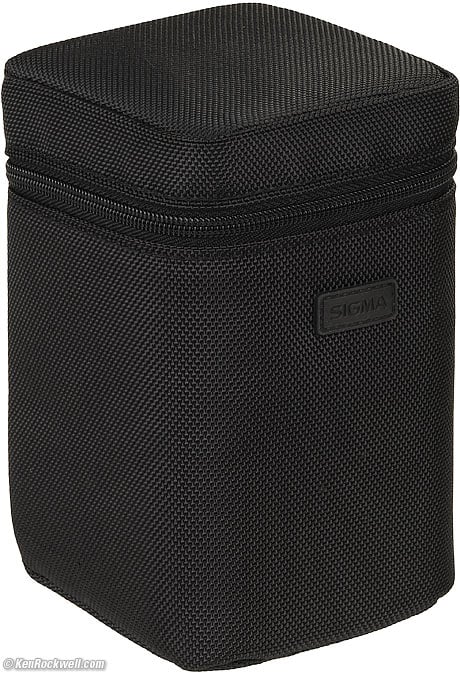
Case, Sigma 8-16mm.
Sigma includes a nice-feeling case.
It's not really a custom fit, so the lens flops around inside.
Made in top
Japan.
Announced top
February 2010
Price top
$700, USA, September 2010.
Packaging top
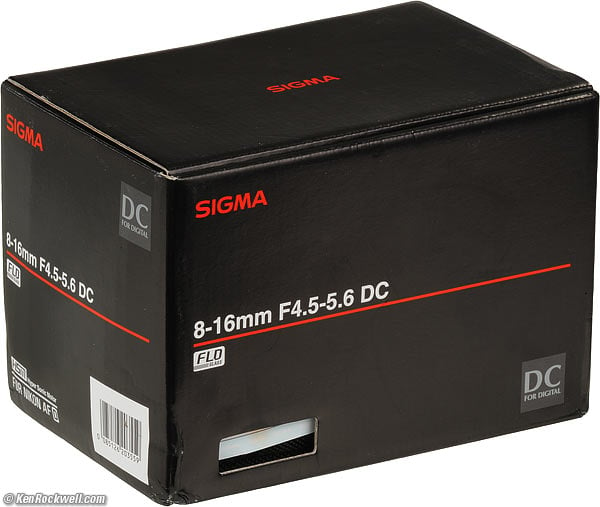
Box, Sigma 8-16mm.
Black corrugated cardboard box, lens in plastic bag inside case inside box. Paperwork outside case, serial number shows through peephole.
Performance top
Intro Specifications Performance Compared Recommendations
Overall Focus Distortion Ergonomics Falloff Filters
Ghosts Color Fringes Maximum Aperture Mechanics
Peripheral Color Shift Sharpness Sunstars
Overall performance top
The Sigma 8-16mm f/4.5-5.6 DC HSM has great optics, in a questionable electromechanical package.
Focus performance top
AF Speed
AF is slow, as ultrawides go.
AF is also noisy and has perceptible vibration as it rattles along. This is not a Nikon or Canon lens!
In dim light, it often won't focus at all, even with an excellent AF illuminator like the one in the Nikon D300.
Even in broad daylight it sometimes won't focus, so take your finger off the shutter, tweak the manual focus ring, and try again.
AF Accuracy
AF seems right-on, but with ultrawides, everything is always in focus anyway.
Manual Focus
Manual focus is horrible because it turns the wrong way on Nikon.
Sigma was too cheap to make it go the correct way, since they share parts with the Canon model.
Worse, since everything is pretty much in focus at every setting anyway, God bless you if you can see anything through the finder to achieve any sort of manual focus. Zone-focus won't work, because you'll always be setting a foot when you want infinity, and vice-versa.
Infinity has no stop, so you can't set it there by feel either.
AF - M Switch
Sigma does this better than Nikon: it is correctly marked AF and M.
Grab the focus ring at any time for instant manual focus override.
Focus Shift while Zooming?
I didn't notice any significant focus shift while zooming.
Heck, you could set it to Manual Focus, tape the ring at about 10 feet, and never worry about autofocus again! This short lens has huge depth-of-field!
Distortion performance top
The Sigma 8-16mm f/4.5-5.6 DC HSM has a lot of barrel distortion at 8mm, and pincushion distortion at 16mm
This can be somewhat corrected by plugging these figures into Photoshop's lens distortion filter. These aren't facts or specifications, they are the results of my research that requires hours of photography and calculations on the resulting data.
DX at 3m |
FX and Film |
|
8mm |
+7.0* |
+2.5* |
12mm |
+1.2 |
vignettes |
16mm |
-1.5 |
vignettes |
© 2010 KenRockwell.com. All rights reserved.
* Waviness remains.
This table gets the edges sort of straight. The complex signature of the 8-16mm means that if you're photographing brick walls, the outsides distort even more than the center of the image, so use +5 instead of +7 at 8mm, otherwise the center will appear pinched. In other words, the center distorts differently than the sides, so you'll need something like a module for DxO if you demand perfection.
If distortion worries you, shoot at about 14mm, or use the Nikon 10-24mm, which has somewhat less distortion.
Ergonomics (handling and ease-of-use) performance top
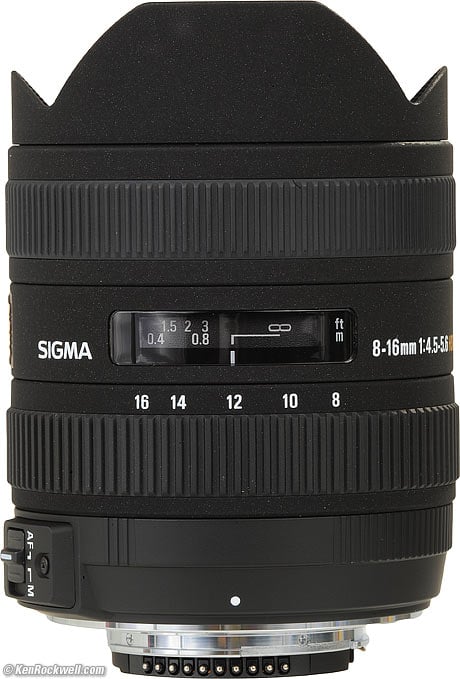
Sigma 8-16mm f/4.5-5.6 DC HSM.
Except that manual focus runs backwards and that the focus scale uses the same dim white for both feet and meters, ergonomics are great.
Falloff (darkened corners) performance top
Falloff on DX isn't a problem, except wide-open at the widest end. It's as expected for an ultra-ultra wide: moderately strong wide-open at the wide end, and moderate stopped down.
I've exaggerated this by shooting a gray field and placing these on a gray background.
Sigma 8-16mm f/4.5-5.6 DC HSM falloff on DX at infinity, no correction.
© 2010 KenRockwell.com. All rights reserved.
|
Filters, use with performance top
There is no way to use filters.
There is a ring that slips over the front and holds 72mm filters, but it makes the images just circles against black!
You might be able to tape a gel over the rear, but good luck as you'll have to attach it to the rear black index ring (on Nikon). Try double-sided tape. The rear group stays inside the rear black ring.
Ghosts performance top
If you put the direct disk of the sun in your image and look around in the dark areas, you'll usually see one small green or red blob.
Even though Sigma warns about the potential for ghosts due to the crazy wide angle of this lens, I'm impressed: it's very good.
Lateral Color Fringes performance top
There are little to no lateral color fringes on the D300 or D3, which would correct them if the lens had any.
Looking at outlines of trees in the corners sometimes there is just the slightest hint of red or blue, but as we expect on Nikon which automatically corrects them, it's not a significant problem. It might be on Canon.
Maximum and Minimum Apertures Performance top
Maximum |
Minimum |
|
8mm |
f/4.5 |
f/22 |
10mm |
f/4.8 |
f/22 |
12mm |
f/5 |
f/25 |
14mm |
f/5.3 |
f/25 |
16mm |
f/5.6 |
f/29 |
Mechanics and Construction performance top
Sigma 8-16mm f/4.5-5.6 DC HSM. enlarge.
The Sigma 8-16mm f/4.5-5.6 DC HSM is one of Sigma's better lenses, meaning still not as good as Nikon or Canon's cheaper lenses.
It's made of metal and plastic on the outside, but I never trust Sigma lenses not to break on me out in the field, which is why I don't own any Sigma lenses.
Forehood
Metal, with freaky fuzzy black sparkle paint.
Midbarrel
Plastic, with freaky fuzzy black sparkle paint.
Rearbarrel
Unpainted plastic.
Focus Ring
Plastic; rubber covered.
Zoom Ring
Plastic; rubber covered.
Focus Helicoids
Feel more like a geartrain.
Depth-of-Field Scale
None.
Internals
Who knows?
Aperture Ring
None.
Mount
Some sort of shiny turned metal.
Sort of gritty rotating home on Nikon, not smooth like better lenses.
Markings
Paint.
Identity
Paint on barrel.
Serial Number
Sticker on bottom rear of barrel.
Ass-Gasket (dust seal at mount)
No.
Noises When Shaken
Very mild clicking.
Made in
Japan.
Peripheral Color Shift performance top
Most ultrawide lenses shift color balance towards blue in the corners.
This Sigma does none of that, probably due to its coatings which appear to change color to compensate with angle.
Bravo!
Sharpness performance top
Warning 1: Image sharpness depends more on you than your lens.
Warning 2: Lens sharpness doesn't mean much to good photographers.
With those caveats, the Sigma 8-16mm f/4.5-5.6 DC HSM is a very, very sharp lens. It's sharp at every setting and aperture, with only the sides at 8mm a little bit softer than other settings. Even then, the Sigma 8-16mm is still sharp wide-open at 8mm.
I've come to expect this in the 2010 decade: lenses today are just about perfect optically; this isn't the 2000s anymore.
Sunstars performance top
Since this small-format lens is only shot on digital, which has limited highlight dynamic range, sunstars are rarely seen. If they are, they are not particularly symmetrical 14-pointets tars.
Compared performance top
Intro Specifications Performance Compared Recommendations
This Sigma is as sharp as the Nikon 10-24mm.
The Nikon 10-24mm and Nikon 12-24mm are better made, focus better, have less distortion, and offer the ability to use standard 77mm filters, but they don't go to 8mm. The Tokina 11-16mm is also much better made than this Sigma.
Recommendations top
Intro Specifications Performance Compared Recommendations
The Sigma 8-16mm f/4.5-5.6 DC HSM is the lens to get if you need the absolute widest possible lens on mini-format DSLRs. I own the Nikon 10-24mm because I prefer its quality, focusing, mechanics and ability to use filters over the 8mm versus 10mm widest setting, and of course the Nikon 10-24mm covers a broader zoom range to 24mm instead of 16mm.
I'm not a fan of this Sigma's inability to use filters, questionable mechanics and balky autofocus, however its optics are excellent (all be they often distorted). If you're a whiner, be prepared for AF that doesn't always focus, and a lot of barrel distortion at 8mm.
If you're not as afraid of Sigma as I am (I'm funny about quality) and you need the widest possible lens, by all means, get this Sigma. Its images are excellent!
I'd leave the 72mm cap and sleeve in the box, and use an extra-small $13 LensCoat Hoodie instead. Likewise, leave the dinky Sigma rear cap in the box, and use a real $9 Nikon rear cap instead.
Help me help you top
I support my growing family through this website, as crazy as it might seem.
The biggest help is when you use any of these links to Adorama, Amazon, B&H, eBay, Ritz, Calumet and J&R and when you get your goodies. It costs you nothing, and is this site's, and thus my family's, biggest source of support. eBay is always a gamble, but all the other places always have the best prices and service, which is why I've used them since before this website existed. I recommend them all personally.
If you find this page as helpful as a book you might have had to buy or a workshop you may have had to take, feel free to help me continue helping everyone.
If you've gotten your gear through one of my links or helped otherwise, you're family. It's great people like you who allow me to keep adding to this site full-time. Thanks!
If you haven't helped yet, please do, and consider helping me with a gift of $5.00.
As this page is copyrighted and formally registered, it is unlawful to make copies, especially in the form of printouts for personal use. If you wish to make a printout for personal use, you are granted one-time permission only if you PayPal me $5.00 per printout or part thereof. Thank you!
Thanks for reading!
Mr. & Mrs. Ken Rockwell, Ryan and Katie.
Home Donate New Search Gallery How-To Books Links Workshops About Contact

